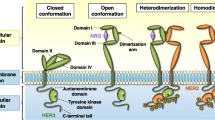Abstract
The HER3 protein contributes to malignant transformation in breast and other cancer types as a consequence of elevated levels of expression, particularly in the presence of the HER2 protein. We show here that an antibody, called SGP1, to the extracellular domain of the HER3 receptor can inhibit completely Neuregulin stimulated growth of cultured breast cancer cells. Herceptin is a humanised monoclonal antibody to the HER2 protein which has an established role in the treatment of some patients with breast cancer. We demonstrate that Herceptin and SGP1 can bind simultaneously to breast cancer cells expressing both the HER2 and HER3 proteins. In the presence of moderate levels of Herceptin, addition of the SGP1 monoclonal antibody gave a dose-dependent inhibition of the growth of cells expressing both the high levels and moderate levels of HER2. The combination of Herceptin with SGP1 is effective in inhibiting breast cancer cell growth in cases where both HER2 and HER3 are expressed.




Similar content being viewed by others
References
Austin CD, De Maziere AM, Pisacane PI, van Dijk SM, Eigembrot C, Sliwkowski MX, Klumperman J, Scheller RH (2004) Endocytosis and sorting of ErbB2 and the site of action of cancer therapeutics trastuzumab and geldanamycin. Mol Biol Cell 15:5268–5282
Baselga J, Swain SM (2009) Novel anticancer targets: revisiting ERBB2 and discovering ERBB3. Nat Rev Cancer 9:463–475
Campbell MR, Amin D, Moasser MM (2010) HER3 comes of age: new insights into its function and role in signalling, tumour biology, and cancer therapy. Clin Cancer Res 16:1373–1383
Citri A, Skaria KB, Yarden Y (2003) The deaf and the dumb: the biology of ErbB-2 and ErbB-3. Exp Cell Res 284:54–65
Dunn M, Sinha P, Campbell R, Blackburn E, Levinson N, Rampaul R, Bates T, Humphreys S, Gullick WJ (2004) Co-expression of Neuregulins 1, 2, 3, and 4 in human breast cancer. J Pathol 203:672–680
Fabian MA et al (2005) A small molecule-kinase interaction map for clinical kinase inhibitors. Nat Biotechnol 3:329–336
Hamburger AW (2008) The role of ErbB3 and its binding partners in breast cancer progression and resistance to hormone and tyrosine kinase directed therapies. J Mammary Gland Biol Neoplasia 13:225–233
Hayes NLV, Howard-Cofield E, Gullick WJ (2004) Green fluorescent protein as a tool to study epidermal growth factor receptor function. Cancer Lett 206:129–135
Jones JT, Akita RW, Sliwkowski MX (1999) Binding specificities and affinities of egf domains for ErbB receptors. FEBS Lett 447:227–231
Knuefermann C, Lu Y, Liu B, Jin W, Liang K, Wu L, Schmidt M, Mills G, Mendelsohn J, Fan Z (2003) HER2/PI-3 K/Akt activation leads to a multidrug resistance in human breast adenocarcinoma cells. Oncogene 22:3212–3295
Koutras AK, Fountzilas G, Kalogeras KT, Starakis I, Iconomou G, Kalofonos HP (2010) The upgraded role of HER3 and HER4 receptors in breast cancer. Crit Rev Oncol Hematol 74:73–78
Liu B, Ordonez-Ercan D, Fan Z, Edgerton SM, Yang X, Thor AD (2007) Downregulation of erbB3 abrogates erbB2-mediated tamoxifen resistance in breast cancer cells. Int J Cancer 120:1874–1882
McIntyre E, Blackburn E, Brown PJ, Johnson CG, Gullick WJ (2010) The complete family of epidermal growth factor receptors and their ligands are co-ordinately expressed in breast cancer. Breast Cancer Res Treat 122:105–110
Motoyama AB, Hynes NE, Lane HA (2002) The efficacy of ErbB receptor-targeted anticancer therapeutics is influenced by the availability of epidermal growth factor-related peptides. Cancer Res 62:3151–3158
Prigent SA, Gullick WJ (1994) Identification of c-erbB-3 binding sites for phosphatidylinisitol 3′-kinase and SHC using an EGF receptor/c-erbB-3 chimera. EMBO J 13:2831–2841
Rajkumar T, Gullick WJ (1994) A monoclonal antibody to the human c-erbB3 protein stimulates the anchorage-independent growth of breast cancer cell lines. Br J Cancer 70:459–465
Schoeberl B et al (2010) An ErbB3 antibody, MM-121, is active in cancers with ligand dependent activation. Cancer Res 70:2485–2494
Sergina NV, Rausch M, Wang D, Blair J, Shokat KM, Moasser MM (2007) Escape from HER-family tyrosine kinase inhibitor therapy by the kinase-inactive HER3. Nature 445:437–441
Shi F, Telesco SE, Radhakrishnan R, Lemmon MA (2010) ErbB3/HER3 intracellular domain is competent to bind ATP and catalyze autophosphorylation. Proc Natl Acad Sci USA 107:7692–7697
Tzahar E, Waterman H, Chen X, Levkowitz G, Karunagaran D, Lavi S, Ratzkin BJ, Yarden Y (1996) A hierarchical network of interreceptor interactions determines signal transduction by Neu differentiation factor/Neuregulin and epidermal growth factor. Mol Cell Biol 16:5276–5287
Van der Horst EH, Murgia M, Treder M, Ullrich A (2005) Anti-HER-3 MAbs inhibits HER-3-mediated signalling in breast cancer cell lines resistant to anti-HER-2 antibodies. Int J Cancer 115:519–527
Zhou BB et al (2006) Targeting ADAM-mediated ligand cleavage to inhibit HER3 and EGFR pathways in non-small cell lung cancer. Cancer Cell 10:39–50
Acknowledgments
The authors are grateful to the E B Hutchinson Charitable Trust for financial support for E.B. and to the Breast Cancer Campaign for S.Z. and M.L.M.
Conflict of interest
None.
Author information
Authors and Affiliations
Corresponding author
Rights and permissions
About this article
Cite this article
Blackburn, E., Zona, S., Murphy, M.L. et al. A monoclonal antibody to the human HER3 receptor inhibits Neuregulin 1-beta binding and co-operates with Herceptin in inhibiting the growth of breast cancer derived cell lines. Breast Cancer Res Treat 134, 53–59 (2012). https://doi.org/10.1007/s10549-011-1908-1
Received:
Accepted:
Published:
Issue Date:
DOI: https://doi.org/10.1007/s10549-011-1908-1




